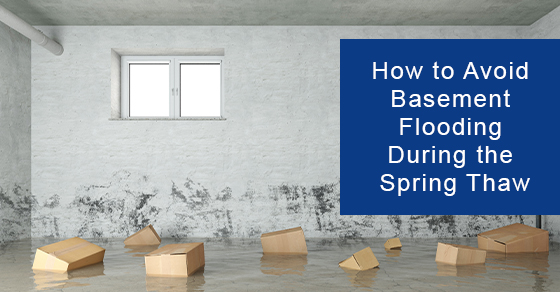
How to Avoid Basement Flooding During the Spring Thaw
After a long cold winter, we always look forward to spring. It’s nice not to have to bundle up in all our winter clothes to go outside. We can start enjoying the longer days, the warmer weather, and the beautiful flowers. Unfortunately, one of the downsides of spring is basement flooding. Between all the snow melting and the rain that comes with spring, basement flooding can be a real concern. The average flooded basement can cost up to $43,000 to repair, and that’s just the cost in money. Many use the basement for storage, so if it floods, you could lose priceless mementos as well as having to go through all the hassle of having it fixed. The good news is that there are ways to reduce the risk of basement flooding during the spring thaw. They are:
- Installing backwater valves and sump pumps.
- Fixing any drainage issues.
- Have your plumbing inspected.
Installing Backwater Valves and Sump Pumps
Two great ways to help prevent basement flooding are backwater valves and sump pumps. A backwater valve is installed in the sewer pipe in the basement, and it will automatically close if any sewage backs up from the main sewer. The job of a sump pump is to pump and send any excess water away from your house. Sump pumps are generally wired directly into your electrical system, so make sure it has a battery backup in case the power fails.Fixing Drainage Issues
Another way to prevent basement flooding during a spring thaw is to work on drainage issues you may have. You should:- Clear away any large amounts of snow directly near your house. If all the snow melts suddenly, the water may not have enough time to drain properly and it could end up leaking into your basement.
- Keep your eavestroughs and downspouts clear. If these are clogged, water could build up, causing drainage issues.
- Check your landscape; are there areas that water pools up? If so, you may need to manually pump or clear the water out. Before the next winter comes, consult a landscaper to see if there are ways to fix your landscaping issues.
Have Your Plumbing Inspected
It’s not enough just to have things like sump pumps and backwater valves installed; you also need to make sure they are properly maintained. It can be tempting to avoid calling a plumber and spending the money to do this. However, the hassle and expense of dealing with a plumber is far less than what you’ll have to deal with if your basement is flooded. Make an appointment to have your drains, sump pump, and any other drainages devices inspected. If your plumber finds any issues, have them fixed right away.How can Oegema, Nicholson & Associates help me with my home insurance needs?
It’s important to make sure you understand what your home insurance does and doesn’t cover when it comes to basement flooding. There are two important main types of flooding that can occur:- Overland flooding. This is almost exactly what it sounds like: water flows out of a river or pond if there’s a flash flood, and then into your house via the doors, windows, or even cracks in the foundation.
- Sewer backup. This can happen if your local sewer system is overwhelmed and water flows up through it into your home. This is even worse than overland flooding, as the water is contaminated. Not only are your possessions, furniture, and carpets damaged, but they could also make you sick.
- Explain the two different types of flooding coverage to you.
- Add flooding coverage to your policy if you don’t already have it, or increase your coverage if necessary.
- Talk to you about what you should do if your basement is flooded.
- Getting your possessions repaired or replaced.
- Having your basement cleaned up as necessary.
- Temporarily moving out if it’s not safe to stay in your house.

